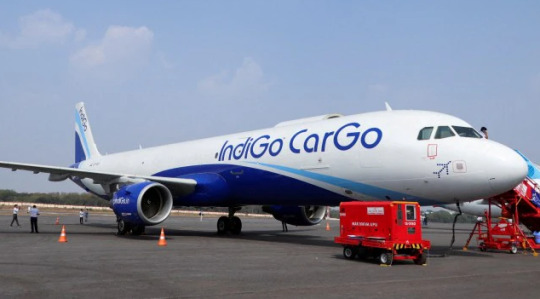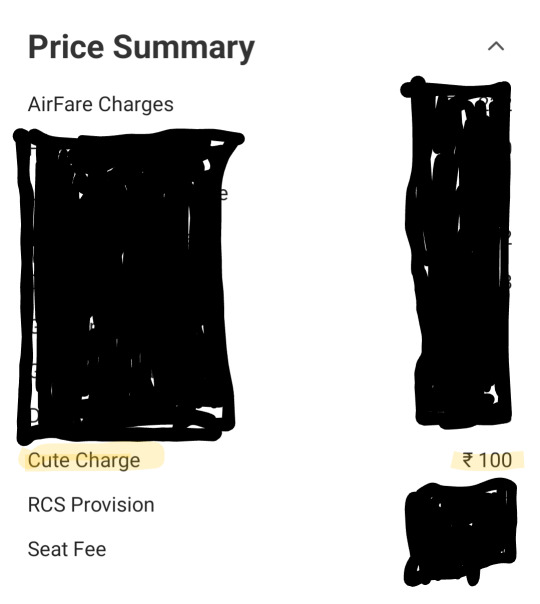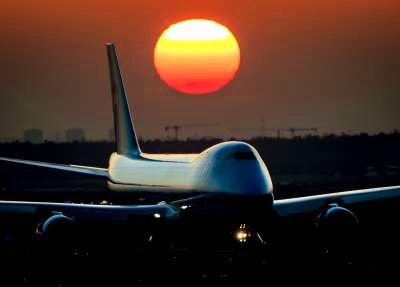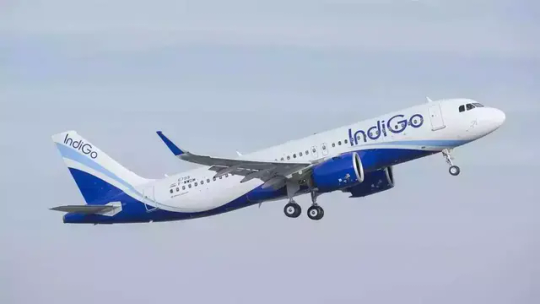#airlines indigo
Link
0 notes
Text
Weekend musings - the weekly column which looks at interesting tit bits in aviation
2 notes
·
View notes
Text
IndiGo announces 19 new connecting flights between India and Europe from 23rd November
IndiGo announces 19 new connecting flights between India and Europe from 23rd November
With a view to enhance international connectivity, IndiGo announced the launch of connecting flights from Turkey to Portugal and Switzerland through its codeshare partnership with Turkish Airlines.
These new routes and frequencies, effective November 23, will provide new options and greater capacity for customers looking to travel between India and Europe during the upcoming holiday season.
Vinay…

View On WordPress
#23rd#announces#aviation#connecting#Europe#flight#flights#India#Indigo#indigo airline#November#portugal
2 notes
·
View notes
Text
IndiGo to Introduce Business Class: A Game-Changer in Indian Aviation
IndiGo, India’s largest airline, is set to revolutionize air travel with the introduction of a tailor-made business class product on the country’s busiest routes by the end of this year. This strategic shift in IndiGo’s offering comes after 18 years of championing the one-size-fits-all single-class cabin configuration.

A Tailored Premium Experience
“This product will be available on the busiest and business routes of the nation and will be operational before the end of this year. Coming August, around IndiGo’s anniversary, more details on product offering, launch date, and routes will be unveiled,” the airline announced in a statement.
Redefining Premium Travel
IndiGo aims to redefine premium travel in India, catering to the evolving aspirations of Indian society and increasing accessibility to premium services. “It will create a desired option for many who are aiming to travel business, perhaps for the first time in their lives,” IndiGo added.
Competition and Strategic Decisions
Industry experts attribute this move to the competition from Tata group’s full-service carriers (FSCs) Air India and Vistara, catering to business travelers and those seeking extra comfort. Premium classes typically yield higher revenues compared to economy class, albeit with higher operational costs.
Expansion Plans and Long-Haul Ventures
IndiGo is not stopping with the introduction of a business class. The airline is also working on launching a loyalty program and has plans to enter the long-haul market with an order of 30 Airbus A350–900 wide-body aircraft.
Global Aspirations
IndiGo’s decision to introduce a business class on domestic routes is seen as a precursor to offering premium services on international routes as well. With a focus on high business travel and medium to long-haul international routes, IndiGo aims to compete with both domestic and foreign carriers.
Conclusion
As IndiGo continues to dominate the domestic aviation sector with over 60% market share, its foray into the business class segment signifies a significant milestone in Indian aviation. With a commitment to innovation and customer satisfaction, IndiGo is poised to redefine the flying experience for Indian travelers.
Stay tuned for more updates as IndiGo reshapes the aviation landscape in India and beyond.
0 notes
Text
Why Do Indian Airlines Keep Crashing? Unveiling the Challenges of a Soaring Industry
After a 13-hour delay, a passenger angrily slapped pilot Radhika Apte. She shared on her Instagram that she and all the passengers were stuck on the aerobridge for hours without water or access to toilets. 10-hour flight delays have become common, and airlines only offer a sorry excuse, if you're lucky.
For India to become the 'Golden Bird,' the aviation industry needs to thrive. Think about it. Has your flight been delayed for hours in the last few months? Has your baggage been misplaced? Or did you miss your flight due to a last-minute terminal change? If so, this blog is for you.
Today, we'll explore the harsh realities of India's aviation industry. We'll understand why Indian airlines are failing, the challenges of running an airline business in India, how airlines make money, and the problems they face today. There are 5 core reasons for these issues. If we can address them, no one can stop us from becoming the 'Golden Bird.'
This blog is especially interesting for travel enthusiasts like you and me. If you agree with us, like the blog and follow us.
India is the world's fastest-growing aviation market. Last year, 15 crore people traveled domestically and 7 crore internationally. This number is more than the population of 180 countries, demonstrating how many Indians love to fly. There's a market principle: The more demand, the more revenue, and the more revenue, the more profit. But Indian airlines are different. In the past few years, Jet Airways shut down, GoAir declared bankruptcy, and Kingfisher Airlines crashed. Why is this happening in a market with so much demand?
Let's delve into the first reason. Reason number one is capital. Money is required to run any business, but an airline business requires a lot of money. Richard Branson, founder of Virgin Atlantic Airline, famously said, "If you want to be a millionaire, start with a billion dollars and then start an airline." JRD Tata, India's first aviator who started Air India, understood this as well. He knew operating airlines was tough.
What can be the biggest expense of an airline? Can you guess? Of course, it's the planes themselves. Airlines either buy aircraft directly from Boeing or Airbus or lease them, paying rent. IndiGo recently placed the biggest purchase order in aviation history, purchasing 500 A320 planes from Airbus for delivery between 2030 and 2035. Air India, on the other hand, leases Boeing planes from the American company Delta. Lease essentially means renting, so they have monthly payments. The cost of buying a plane is high, so companies use different methods to manage these high costs.
Now, let's discuss the second major cost. Airlines spend 35-50% of their budget on fuel, which is aviation fuel or ATF. It's a mixture processed from crude oil that powers jet engines and ensures they function well at high altitudes without the fuel freezing. ATF prices in India are linked to international crude oil prices. Premium airlines like Kingfisher lost a lot of money due to a price jump between July 2007 and 2008. Since India doesn't have its own oil reserves and must import it, Gulf and American airlines have an advantage because they control oil or the dollar, while India controls neither. Price fluctuations significantly affect Indian airlines.
The second reason is uncertainty. If you've traveled around Delhi during winters, you've likely heard of the "fog season." Low visibility can ground aircrafts. Pilots and passengers are ready, but the flight cannot take off until visibility improves. As frequent flyers, we understand that some things are beyond the airlines' control. However, if a flight is delayed, the airlines should provide accurate information to passengers. For significant delays, they should arrange food or allow passengers to cancel their flights. This is within the airline's control. Slapping the pilot is an extreme and unacceptable reaction. But if we know flights won't fly due to fog, why aren't better policies implemented? Passengers miss flights for being a minute late, and airlines charge extra for even 1 kg of overweight luggage, but they face no fines or compensation for their mistakes. It seems the responsibility lies solely with the passenger, despite the saying "the customer is king." Once we check in our luggage, we're at the airline's mercy, forced to comply with their policies. This is a surefire way to anger customers. Imagine someone traveling from Delhi to Bangalore for a one-day meeting and their flight is delayed by 10 hours. In such a situation, the delay makes the travel pointless. Shouldn't they have the option to cancel the flight?
Events like COVID-19 negatively impact the global aviation industry. In 2020, according to estimates, the global airline industry suffered losses of $84 billion. As pandemic restrictions lifted, the aviation sector began to pick up. These losses reduced to $51 billion in 2021 and $11.6 billion in 2022.
During peak seasons like Diwali and New Year, demand for travel is high, but it dips significantly during the rest of the year. This uneven distribution of demand creates challenges for airlines. Airlines rely heavily on business travelers for weekday travel.
The third reason is operations. Airlines generate revenue through three main avenues: passenger revenue, cargo revenue, and food and beverage revenue. Passenger revenue includes ticket sales and convenience fees, which some argue shouldn't exist since the booking is done on the airline's website. Additional passenger revenue comes from modifications, cancellations, seat selection, excess baggage, and special service requests. Every airline also deals in cargo, either through dedicated cargo flights or parcel services. Full-service airlines like Air India and Vistara offer complimentary meals on domestic flights, while budget airlines like IndiGo, SpiceJet, and GoAir don't. Passengers on these airlines can pre-book meals or purchase them from the in-flight menu.
Typically, Indian commercial airlines generate most of their revenue from passenger-related services. However, the unpredictable nature of passenger numbers makes it difficult for airlines to accurately predict the number of airplanes needed. On the other hand, operational expenses are high. Pilot salaries, cabin crew salaries, engineer salaries, and other crew member salaries are significant expenses for airlines. When planes are flying, they consume fuel, and when they're on the ground, airlines incur grounding charges, which are essentially aircraft parking charges. In India, domestic and international flights take off from the same terminals, increasing these charges. Additionally, grounded aircraft from insolvent airlines occupy space at airports without paying for it.
As we learned earlier, Boeing and Airbus are foreign companies. For major repairs, planes need to be sent to these manufacturers' facilities, which can be outside India. Delays in these repairs can ground airplanes and endanger passenger safety, making them non-negotiable. GoAir, a low-cost airline that shut down last year, is a prime example. They had to ground most of their planes because their engines turned out to be faulty. Pratt & Whitney, the engine manufacturer, couldn't deliver spare parts on time, leading to the airline's shutdown.
The government also plays a significant role in the aviation industry. The policies they create can heavily impact airline businesses. For instance, during the lockdown from May 2020 to August 2022, the government mandated minimum fares between Rs. 2,900 and Rs. 8,800 for flights less than 40 minutes. This price cap created major problems for airlines. Additionally, both VAT and excise duty are levied on aviation turbine fuel (ATF). During COVID-19, Indian refiners prioritized exporting ATF over supplying it domestically, leading to an export tax on ATF. These high taxes increase fuel costs, squeezing airline profit margins. Furthermore, VAT rates on ATF vary by state, similar to petrol prices. So, if an airline frequently lands at an airport with a high VAT rate, they incur higher fuel costs. All these factors put Indian airlines at a disadvantage.
The final reason is brand loyalty. While India has a high total number of airline passengers due to its large population, per capita travel is low. Only 1% of India's population contributes to about 45% of all flights. This makes it challenging to build and maintain brand loyalty. Consider Kingfisher Airlines, a former premium airline, and IndiGo, a budget airline. Kingfisher was the first to offer complimentary headphones and provided ample legroom, making economy class feel more aspirational. IndiGo, on the other hand, focused on a bare-bones approach with minimal legroom and no complimentary meals. Today, IndiGo holds 62% of India's domestic air travel market share, while Kingfisher is defunct. For a large part of the Indian population who haven't even been on a plane, the experience of air travel itself is a novelty. Features and amenities come secondary to affordability. In a market where customers prioritize the cheapest option, building brand loyalty is difficult. Additionally, negative incidents can quickly tarnish an airline's reputation. For instance, some Boeing aircraft have experienced issues like wheels falling off during takeoff, engines catching fire, and sudden door openings. These incidents scare people and make them hesitant to fly. Similarly, if an airline misplaces your luggage, you'd likely be hesitant to fly with them again.
In conclusion, several factors contribute to the challenges faced by the Indian aviation industry. Fuel prices and dollar rates are beyond India's control. Government taxes are high, and policy changes can significantly impact businesses. Passenger concerns arise due to bad weather and mismanagement. Brand loyalty is difficult to build due to a combination of factors: limited travel experience for a large portion of the population, focus on affordability over brand differentiation, and potential negative incidents. Despite these challenges, the aviation industry remains crucial for India's growth. The country's diverse geography can be better connected through air travel, facilitating trade, tourism, and overall development. The real potential lies in tier 2 and tier 3 cities, where a growing population aspires to travel. As disposable incomes rise, so will the number of air travelers in India. These two factors are directly linked.
If you found this blog interesting, please share it with your friends and subscribe to our channel. The airline business teaches us a valuable lesson: to be profitable, you must keep your costs low. To make India the 'Golden Bird' again, we need to make air travel accessible. The right policies must be implemented to balance business needs with consumer satisfaction. Airlines need to build strong brands that prioritize customer experience. Sharing this message is important because a thriving aviation industry can significantly contribute to India's progress.
Thank you for reading this blog! Your support means a lot to us. Don't forget to follow us.
1 note
·
View note
Text

Charged CUTE by Airlines, guilty of all charges ☺️🥺☺️
[alt text: Screenshot of an airplane price summary with a lot of rows crossed out in black. A row highlighted in yellow says Cute Charges on the left, and 100 rupees on the right. ]
#Ahoy liveblog#I mean I'm sure cute means something else#I just couldn't resist the pun#Thanks indigo Airlines
0 notes
Text
Streamlining Your Travel Plans: Explore Hassle-Free Air Ticket Availability
Discover a seamless way to secure your air tickets with our comprehensive guide. From real-time updates to best practices, ensure a stress-free travel experience. Explore the latest options for availability of air tickets!
#leh to delhi flight defence quota#armed forces discount in indigo airlines#flight tickets enquiry#availability of air tickets
0 notes
Text
The one destination stations of IndiGo
IndiGo – the country’s largest airline has been growing rapidly in terms of both fleet, reach and expanse since 2018. I have often described the airline’s network and station selection as “find a station such that you can bombard it with flights from multiple different places’ ‘. This largely held true for its narrowbody network until it started flights in the North East and subsequently last…

View On WordPress
#Aviation Blogs#Indian Aviation#Indian aviation blogs#Indian aviation news#IndiGo#IndiGo airline network analysis#IndiGo airline one flight stations#IndiGo network
0 notes
Text
#aviation regulations#aviation safety#compliance#DGCA#financial penalty#IndiGo Airlines#operational procedures#pilots' license suspension#safety standards#special audit#systemic deficiencies#tail strike incidents
0 notes
Text
IndiGo| goair | indigo airlines | airlines | indigo flight | indigo careers | indigo news
Indigo and Go First are getting the cheapest tickets of the year, get only 6139 International Flight chance
Passengers can travel from March 12 to September 30, 2023। But for this you have to book tickets by 24 February
Do you plan to roam this year? You do not have to worry because you are getting a chance to travel cheaply by September this year। Two of the country’s major airlines have…

View On WordPress
0 notes
Text
ಎಕ್ಸ್ಕ್ಯೂಸ್ ಮೀ, ಗುಟುಕಾ ಉಗಿಯಲು ವಿಮಾನದ ಕಿಟಕಿಯ ಬಾಗಿಲನ್ನು ತೆರೆಯುವಿರಾ?
Viral Video : ಸಂಸದ ತೇಜಸ್ವಿ ಸೂರ್ಯ ಇತ್ತೀಚೆಗಷ್ಟೇ ವಿಮಾನದಲ್ಲಿ ತುರ್ತು ನಿರ್ಗಮನ ಬಾಗಿಲನ್ನು ತೆರೆದ ಪ್ರಕರಣ ಇನ್ನೂ ಹಸಿಹಸಿಯಾಗಿಯೇ ಇದೆ. ಇದಕ್ಕೆ ಸಾಕ್ಷಿ ಎಂಬಂತೆ ಈ ಪ್ರಕರಣದ ಸುತ್ತ ಅನೇಕ ಮೀಮ್ಗಳು, ಜೋಕ್ಗಳು, ಕಾರ್ಟೂನ್ಗಳು ಇನ್ನೂ ನಮ್ಮನ್ನು ನಗೆಗಡಲಲ್ಲಿ ತೇಲಿಸುತ್ತಲೇ ಇವೆ. ಹೀಗಿರುವಾಗಲೇ ಯುವಕನೊಬ್ಬ ಗುಟ್ಕಾ (Gutka) ಉಗಿಯಲು ವಿಮಾನದ ಕಿಟಕಿಯನ್ನು ತೆರೆಯಲು ಗಗನಸಖಿಗೆ ಕೇಳಿಕೊಂಡ ವಿಡಿಯೋ ವೈರಲ್ ಆಗುತ್ತಿದೆ.
ಇತ್ತೀಚೆಗೆ ಸರದಿಯಂತೆ ವಿಮಾನದಲ್ಲಿ ಸಾಕಷ್ಟು ಅಹಿತಕರ,…
View On WordPress
0 notes
Text
Airlines flew 47 % more pax in 2022 vs 2021, but number still below pre-Covid - Times of India
MUMBAI: Domestic airlines transported 123 million passengers last year as against 83 million in the year 2021 thus registering an annual growth of 47 %, showed monthly traffic data released by the Directorate General of Civil Aviation (DGCA) on Thursday. But the number hasn’t crossed pre-Covid volumes as in the calendar year 2019, domestic airlines had flown 144 lakh passengers. For the month of…
View On WordPress
0 notes
Text

So, I just realised...IndiGo Airlines is around the same age as me and 90% of other people I know
You are sixteen going on seventeen
Baby, it's time to think
Better beware be canny and careful
Baby, you're on the brink
You are sixteen going on seventeen...
0 notes

